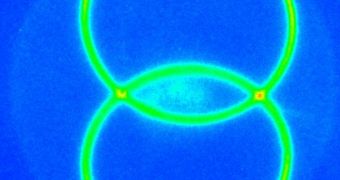A group of investigators recently managed to achieve an important milestone in bringing the quantum computers of tomorrow closer to reality. Physicists in the United Kingdom managed to produce a device that can act as a source of entangled photons. The source can be controlled by the simple passing of an electric current, and this ease-of-use is bound to make it indispensable in future quantum research. Entangling photons is crucial for the next generation of computers, which will boost a computational power that will put even the most advanced supercomputers available today to shame.
Entanglement and superposition are the most important principles of quantum physics. In the former, particles communicate to each other instantly over vast distances, and changes in one's spin, for instance, affect the other's spin right away. The latter refers to the fact that photons can be made to exist in multiple states at the same time. For quantum computers, this translates into the fact that future machines will no longer work with bits of information such as “1s” and “0s.” Photons will exist in a superposition state, meaning that the “1 and 0” option will be added to the mix. Producing quantum computers is basically the same thing as exploiting the inherent uncertainties of quantum physics.
There is also another consequence to using these two principles in practice. Because of the fuzziness associated with superposition, clusters of photons can be easily entangled with each other, allowing computers to conduct numerous calculation threads in parallel. This will be multi-thread technology at its finest, and at a level far exceeding that possible with existing microprocessors. The basic unit of a future computer will be the qubit, or quantum bit, but thus far, methods of producing them reliably proved to be extremely difficult to establish. This is where the new work steps in.
By combining quantum dots (semiconductor regions) with light-emitting diodes (LED), researchers at the Toshiba Research Europe in Cambridge and the University of Cambridge managed to find a way to produce reliable qubits. The group, led by TRE expert Mark Stevenson, says that quantum dots generally emit entangled photons when excited with light, while LED emit light when excited with electrical currents. Through this combination, the team basically obtained a tool that produces entangled photons whenever an electrical current is applied to it.
“The work demonstrates that with relatively simple technology it is possible to obtain entangled photon pairs with sufficient fidelity for relevant applications. Although this result is not so surprising in view of previous work comparing optical and electrical injection, an experimental demonstration was still missing,” says Leibniz Institute for Solid State and Materials Research quantum-dot physicist Armando Rastelli, quoted by Nature News.

 14 DAY TRIAL //
14 DAY TRIAL //